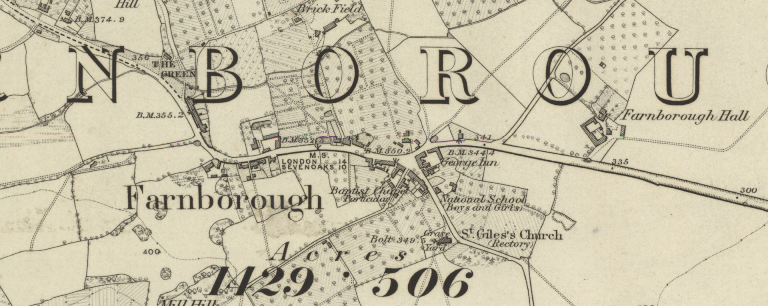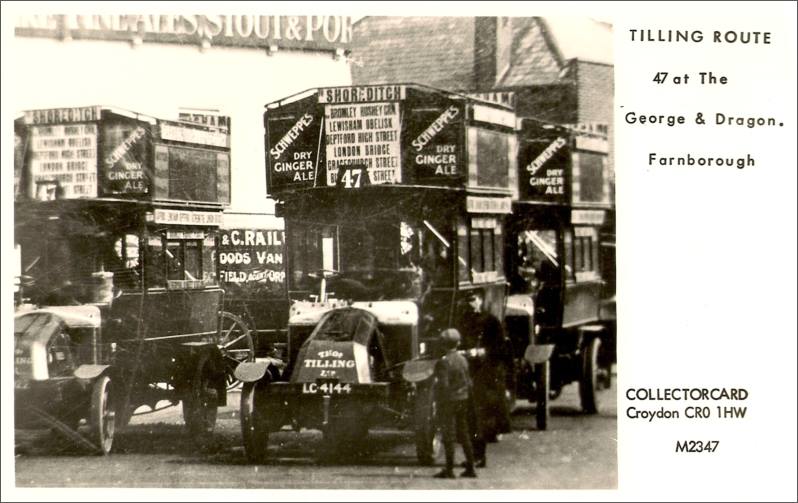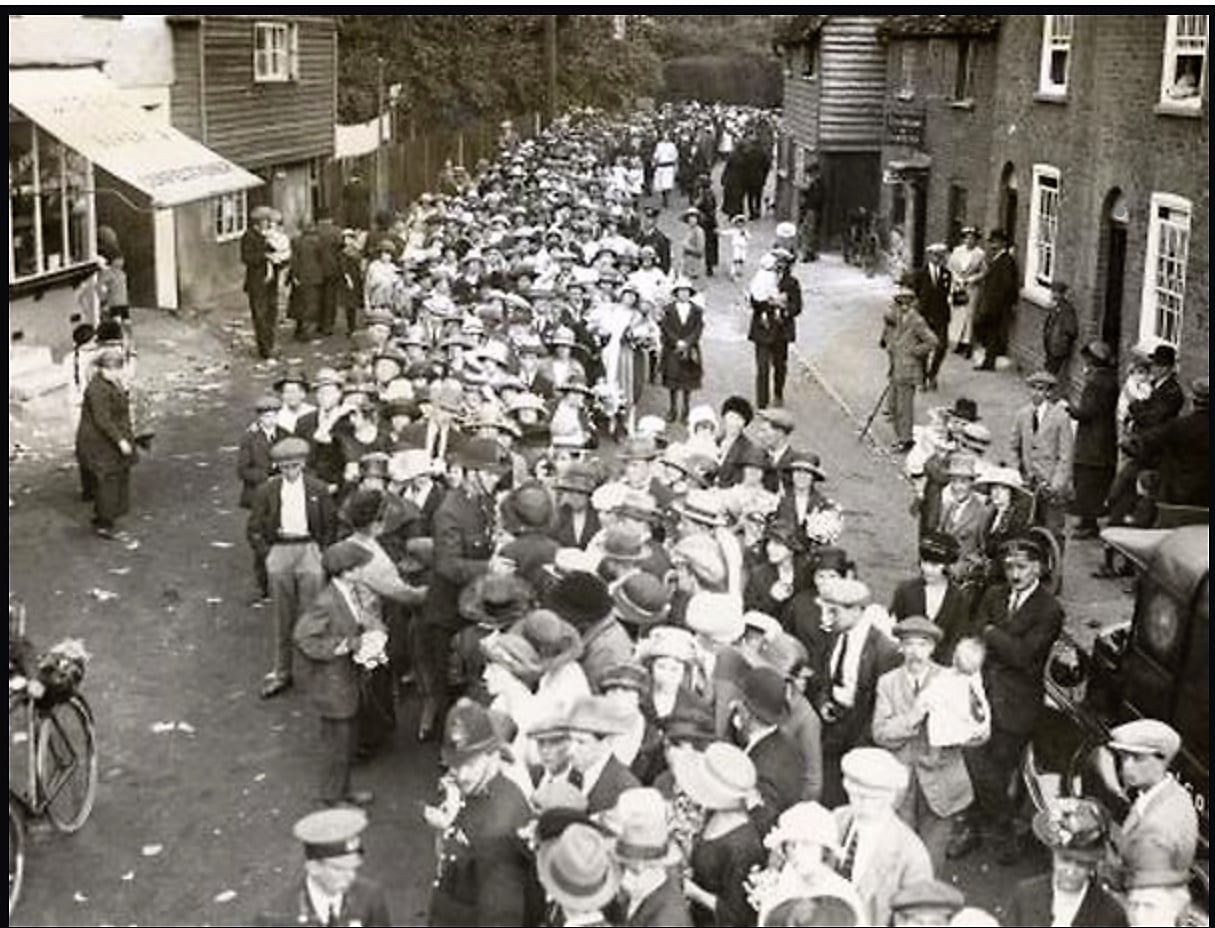FARNBOROUGH AND THE RAILWAY
There are a great many villages and indeed small towns in Great Britain that once had a railway, and now do not. But Farnborough is an example of a village that would seem to have been a prime candidate to have a railway connection, but never has. This website is all about the many failed proposals.
Farnborough is now in the London Borough of Bromley, but was for most of its existence in the County of Kent. It is not to be confused with Farnborough in Hampshire, or indeed other places of this name elsewhere.
Despite having a comparatively small population, Farnborough had been well connected for centuries because of its position on the main road from London to Hastings. But travelling by coach had required money, and involved some risk from both highwaymen and the state of the roads. These were only gradually relieved following the creation of the turnpike, opened through Farnborough in 1749. This was the second busiest turnpike road in southern England, exceeded only by the route from London to Dover.
 |
.jpg) |
Come the railway age, and a railway connection to London would have been expected to follow, but this did not happen. There were some fourteen proposals, but none succeeded. Instead two main lines were eventually routed through Bromley and Orpington, at the nearest about one mile away. Had the railway come to Farnborough then the development of the village would surely have been very different.
This website describes the many proposals to bring the railway through or to Farnborough., one page for each proposal. The maps and other details are taken from original documents archived mainly in the Kent County Archive in Maidstone. For each period, for context, there are also more general descriptions of the progress of what became today's main lines, and also some information about what was happening in Farnborough.
Brief histories of the turnpike era that preceded the railway age, and the arrival of the motor bus are included, but for a more comprehensive description of the impact of these on Farnborough refer to the companion website Farnborough Village History
The two photos at the top of all pages show: an early photograph of the platforms at Orpington station, the nearest to Farnborough, and the viaduct on the main line approaching London Bridge soon after opening. The two further photos above show later locomotives of types that would have worked trains in the Kent area.
Railways
Railways came comparatively late to the surrounding area, despite its proximity to London. As a consequence partly of geography, partly of the lack of population and industry, and partly due to inter-company feuding, Bromley, some four miles from Farnborough did not get a railway station until 1862. Orpington, little over one mile away, did not get its line until 1865, nearly twenty-five years after the opening of the terminus at London Bridge.There has never been a railway through Farnborough, but proposals to bring the railway to the village, began in 1845 and spanned 80 years, They included light railways, a tramway, and even an atmospheric railway. Some were approved but failed to come to fruition, either because the necessary finance could not be found, or the promoters decided to invest elsewhere. Many were to come through the centre of the village, using one of two routes as shown in these maps.
|
|
|
The first would have taken the line directly through the village centre, passing to the south of Farnborough Hall. The station would have been where the parade of shops is now. Tubbenden Lane would have required a slight diversion where it meets the High Street. In earlier proposals this would have been a through station, with the line continuing past St. Giles church toward Green Street Green and beyond. In later ones it would have been a branch line terminus. Precise alignments varied.
The second route involved taking a line across Tubbenden Lane to the north of Farnborough Hall, some 100 metres away from the High Street, as shown in the second sample diagram above. This alignment was later used for the Farnborough bypass. Again the line would have continued to Green Street Green.
The various proposals are described in detail on pages accessed using the menu on the right. Had just one of these succeeded, particularly one from the earlier decades, then Farnborough would surely have developed very differently.
It is undoubtedly true that the terrain to the south is challenging. But a further factor was the lack of sufficient population and industry to justify the effort and expenditure. Despite substantial population growth in the country as a whole, that of Bromley actually fell for a while during the early part of the Railway Age and that of Farnborough did not grow as much as would otherwise have been expected.
The first local main line, toward Maidstone, built by the London Chatham and Dover Railway, passed through Bromley and then took the easiest route southward through the Darenth Valley. The second line, built by the South Eastern Railway, could only be completed by undertaking major tunneling work at Polhill and Sevenoaks. Rather than follow the route from their own proposal of 1845 they now made their line as straight as possible, bypassing both Bromley and Farnborough.
The various proposals to bring a railway to or through Farnborough are the subject of this website They are organised by date into four groups. For each of these there are one or more further pages to put the Farnborough proposals into the wider context of how railways were developing throughout the South-East London and Kent area.
About this website
This website was launched in 2024 by transferring and developing a number of pages formerly on the Farnborough Village History website www.farnborough-kent-village.org.ukThe purpose is to tell the story of the many proposals to bring the railway to Farnborough. Had just one of these succeeded than Farnborough would surely be a very different place today.
The editor would welcome feedback, and submission of further material relevant to the subject area. This can be sent to:
Nick Reynolds
nickr306@talk21.com.
FARNBOROUGH
Farnborough is 13.4 miles from London (Charing Cross), about 10 from Sevenoaks, and 350 feet above sea level. Evidence dating from when it was a significant point on the turnpike road can still be seen today.
From ancient times the Parish of Farnborough embraced
the three settlements of Farnborough, Locksbottom and Green Street
Green, although the latter was really just a hamlet prior to
the opening of the Oak Brewery in 1830. Green Street Green was
removed from Farnborough Parish in 1937.
External Links:
Buses
Farnborough’s population remained low throughout the nineteenth century, this at a time when other towns and villages were expanding rapidly. This was of course because the railway never came.Farnborough remained a sparsely populated place, as is shown by this map dating from 1870.

In the early years of the twentieth century the only real development was the ‘parliamentary roads’ (named after Palmerston, Pitt, Cobden and Gladstone) together with the larger houses in Tubbenden Lane. These were built when it was believed that the railway was finally coming. When it did not the builder went bankrupt, and the development was left half complete.

It was not until the advent of the motor bus in the early part of the twentieth century, that the relative decline of Farnborough stabilised. Many businesses in Farnborough grew to serve day trippers coming out of London to 'the Country' by bus. From that point on the accessibility and therefore popularity of the village improved, and population growth accelerated.

Thomas Tilling Ltd’s motor buses started operation on route 47 between Shoreditch and Bromley on 20 July 1912, replacing a horse bus route from ‘The City’ to Lewisham. Joint working with the London General Omnibus Company, London’s principal bus operator, began in 1908, and came to route 47, by then extended south to Farnborough in 1913.
Tea Rooms and other establishments were more than willing to satisfy the needs of day-trippers - see the photo above.


